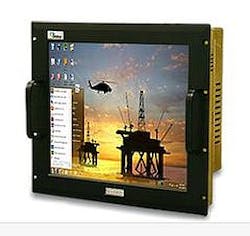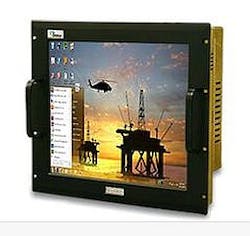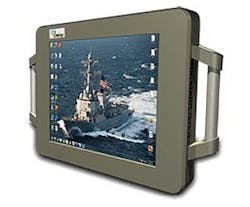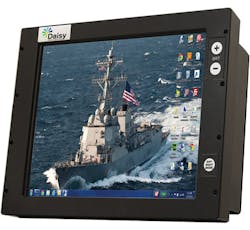Innovations in ruggedized display technology: How to evaluate what makes sense for your application
By Michael Hadaway, general manager of Daisy Data Displays Inc.
When systems engineers are designing a ruggedized display, the most difficult task can be sifting through all the new technology innovations that are available. Features, options, and specs can become overwhelming for a designer, especially for military and aerospace applications where the rugged monitors need to be just as advanced as the weaponry.
LED backlighting
Liquid crystal displays (LCDs) are a relatively mature technology and have made up the majority of displays and monitors since they began to replace traditional cathode ray tube monitors. Although the technology has been around for several years, there are important specs, such as backlights, that are applicable to ruggedized displays.
There are two primary options for backlighting a display. Standard LCD displays use cold cathode fluorescent lamps (CCFLs) for backlighting, while LED backlit LCD displays, or simply LED displays, use a collection of smaller, more efficient light-emitting diodes (LEDs) illuminate screens.
Efficiency is desirable for any application, especially in harsh, rugged applications such as military and aerospace. Compared to a standard incandescent bulb, LEDs emit more lumens per watt, a spec that is unaffected by shape or size of the display. LEDs’ warm up time is also extremely rapid; a red LED indicator can achieve full brightness in less than a microsecond. They also have a lifetime of up to 50,000 hours of use and are much more resistant to shock.
Non-LED displays could be designed in military applications, but engineers should be aware that traditional LCD displays with CCFL backlights can contain Mercury, a component that is restricted for use in U.S. military applications. Specify an LED backlight if efficiency, military use, and speed are pertinent to the application.
Brightness modification flms
If an LED backlight is already a part of the design, then modifications can be made that will improve sunlight readability. A Brightness Enhancement Film (BEF) can be added to an LED backlight to reflect the outdoor light through many optical layers. This can increases a screen’s brightness up to 60%, allowing readability with sunlight.
Typically, if engineers wants sunlight readability, they design the backlight with increased brightness (over 1000 NITs), but this requires more power and the display is more prone to overheating. These designs can get costly because of their need for thermal management systems. A BEF is more efficient and less likely to overheat because the brightness is increased via recycled sunlight, not the strength of the backlight.
BEF for LED backlights are ideal for military and aerospace applications where displays must be used outdoors or in high levels of sunlight. But what display innovations exist in applications of little or no light?
Conventionally, expensive, poly-based, or glass filters must be incorporated into the design in order to achieve compatibility with NVIS goggles. However, the visibility typically yields a green or low-color data view and the physicality of the displays must be designed so filters can be applied.
This technology achieves a full-color interface by changing the brightness range of the backlight to accommodate NVIS goggles. Users push a button to a turn the NVIS-compatible backlight on or off. The convenience and ease-of-use of this dual-readability makes it a significant feature for military and flight simulation applications where displays are needed in both day and night.
The clear, normalized interface is unmatched by traditional NVIS filters and helps to reduce eye fatigue and distractions to the user in all levels of light.
Touch screens
Touch screens are one of the ultimate innovations for quick and responsive interaction between user and device. Because different options are available for rugged displays, including projected capacitive, resistive, and glass-on-glass resistive, how can a designer know they are choosing the right one?
The multi-touch, projected capacitive (PCAP) screens are found in most consumer applications (eg. smart phones and tablets), but designers can usually rule them out for ruggedized displays. They are not very durable and depend on the electrical charge conductive nature of the human body, so a gloved finger and stylus is not recognized.
For rugged applications, resistive touch is much more appropriate. These screens have electrically resistive, flexible plastic or glass layers. The front surface of the resistive touch panel is extremely scratch-resistant with a coating of conductive material, often Indium Tin Oxide.
The advantages of designing a ruggedized display with these screens include low production costs, high resistance to dust and water, compatibility with fingers, gloves and a stylus (ideal for harsh environments), and compliance with MIL Standards 901D, 461, and 810. Engineers can go even further and specify glass-on-glass resistive for an extra level of glass for added scratch resistance and ruggedization.
Vortex cooling systems
One of the more complex features for engineers to incorporate into their design is a cooling system. In addition to being difficult to design, they are typically necessary for display systems in environments with warmer than ambient temperatures or if a high-level of power is needed to operate display functions (such as increased LED brightness). A Vortex cooling system is one option that is both environmentally safe and designed for ease of use.
Vortex coolers are compact compared to typical air cooling systems and can be easily mounted on a display. This makes them ideal for applications where space is limited, such as the flat panel displays found in military aircraft. The positive pressure that is created inside of these systems prevents dust and airborne contaminants from entering the unit in harsh environments. Vortex coolers are also a trending innovation among engineers because there are no moving parts, which mean they have a longer life expectancy with little or no maintenance.
About the author
Michael Hadaway, general manager of Daisy Data Displays Inc. in York Haven, Pa., has over 10 years of mechanical engineering and product design experience. He received his B.S. in Mechanical Engineering and MBA from Penn State University.




